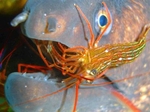Categories Live animals fishes
fishes
|
- Description: Fish color from
beige to gray, silver sides. Slender body with a reddish brown
spot at the base of the Pectoral
fin.
|
|
|
|
|
|
- Description: It has a general tonaildad pink
and electric blue spots on the dorsal side. |
|
|
|
|
|
- Description: Species conspicuous. It has reddish-lists. Radios filamentous dorsal fin. |
|
|
|
|
|
- Description: Body light
brown with a predominance of pink with bluish
reflections. The tips of the caudal fin are
blue. Robust in adults. |
|
|
|
|
|
- Description: Fish of the family of Blennies. They have numerous drawings and depending on the sex or age of fish, their livery changes. . They have eye-shaped tentacles branch.
-Size: up to 9 - 10cm. |
|
|
|
|
|
- Description: It has a black longitudinal band that characterizes it. Thin body and head.Their color is typically black and white. They have eye-shaped tentacles branch. |
|
|
|
|
|
- Description: Dark brown fish. Characteristically a Barbillon on
the chin and pelvic fins in the form of filament bifida.
|
|
|
|
|
|
- Description: Body dark,
sometimes with small white spots. They have three barbels. |
|
|
|
|
|
- Description: It
has a yellow or golden longitudinal lines very bright,
characteristic of these
species, with silver highlights. His eyes are also
yellow. |
|
|
|
|
|
- Description: Back blue, marked by sinuous black lines. Belly white with silver highlights.Torpedo-shaped body,
elongated. |
|
|
|
|
|
- Description: Massive
head and rounded. Reddish, brownish hues
are used for camouflage. It has a strong thorns,
which contain venom.
|
|
|
|
|
|
- Description: Massive head and rounded. Brownish spots which used to camouflage. It has thorns that contain poison. |
|
|
|
|
|
- Description: Head long, solid spines. Its
color is pink with reddish tones. It has spines that contain venom. |
|
|
|
|
|
- Description: Species very colorful and can change color depending on the environment where the fish is. Species very curious and a bit territorial.
- Size: Can reach in large aquariums up to 25 to 30 cm. |
|
|
|
|
|
- Description: Body more thickset than
in other serranids (cabrilla). It resembles aminiature Grouper. Perfect for
small aquariums, which can not be maintained Grouper.Color beige with
dark stripes. |
|
|
|
|
|
- Description: About serranus sp, is
the most requested by its spectacular colors. Very characteristic blue color of
its abdomen. |
|
|
|
|
|
|
|
|
|
|
|
- Description: It has a front stripe between
the eyes (this is the reason for its name) and a dark spot behind
the eyes. |
|
|
|
|
|
- Description: It has a gray color, with blue and yellow longitudinal lines. |
|
|
|
|
|
-Description: very colorful and active species. Males have a brighter color (especially inbreeding season). Highly recommended for aquariums. Sometimes it gets close to the rocks to camouflage. |
|
|
|
|
|
-Description: One of the most characteristic of the Mediterranean wrasse. Species very similar to their family Symphodus sp. about livery and behavior. Fish recommended. |
|
|
|
|
|
|
|
|
|
|
|
-Description:
A laterally
compressed fish, blue-green dorsum with flanks bright silvery
towhite. Something very characteristic black
spots are located at the tips of dorsal, ventraland caudal. -Temperature: 18
º - 24 º C. |
|
|
|
|
|
-Description: It
has a big mouth very characteristic in this
species. Flanks are marked byblue and
yellow oblique stripes. It is a poisonous species. |
|
|
|
|
|
-Description: Body
elongate, with large eyes and silver. It has a black
spot on opercle. |
|
|
|
|
|
-Description: It
has a variable color. Their pectoral fins are quite
large and a bright blue. Something also characteristic of
this species are transformed with their pectoral fins which move along
the bottom when they are quiet or inspecting the ground.
|
|
|
|
|
Prices include VAT
| 31 - 56 of 56 results |
|





























